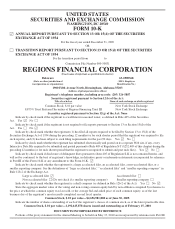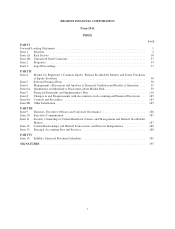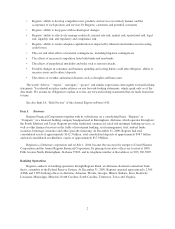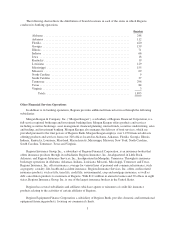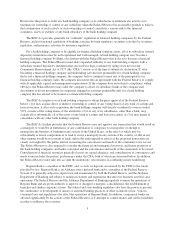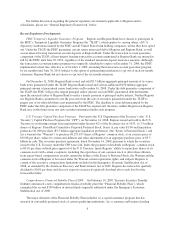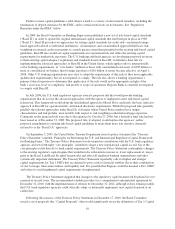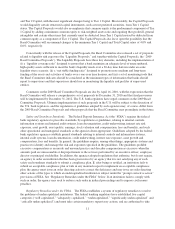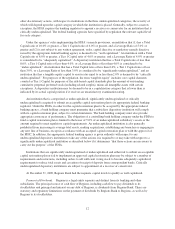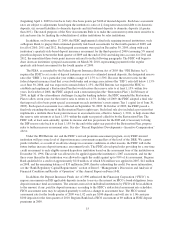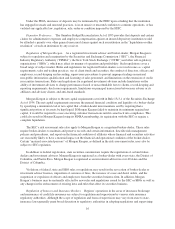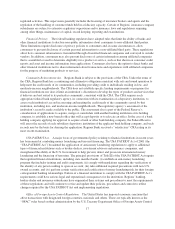Regions Bank 2009 Annual Report Download - page 21
Download and view the complete annual report
Please find page 21 of the 2009 Regions Bank annual report below. You can navigate through the pages in the report by either clicking on the pages listed below, or by using the keyword search tool below to find specific information within the annual report.initiative to fund new consumer loans, small business loans and commercial mortgage asset-backed securities
issuances, (iii) a public-private investment fund intended to leverage public and private capital with public
financing to purchase up to $500 billion to $1 trillion of legacy “toxic assets” from financial institutions, and
(iv) assistance for homeowners by providing up to $75 billion to reduce mortgage payments and interest rates
and establishing loan modification guidelines for government and private programs.
In addition, pursuant to the Federal Reserve’s Supervisory Capital Assessment Program (the “SCAP”), all
banking institutions with assets over $100 billion, such as Regions, were required to undergo a comprehensive
“stress test” to determine if they had sufficient capital to continue lending and to absorb losses that could result
from a more severe decline in the economy than projected. Pursuant to such stress test, it was determined that
Regions was required to raise additional capital. Regions fulfilled the SCAP requirement primarily through the
issuance of common and preferred securities. The Company’s public equity offering of common stock,
announced May 20, 2009, resulted in the issuance of 460 million shares at $4 per share, generating proceeds of
approximately $1.8 billion, net of issuance costs. At the same date, the Company issued 287,500 shares of
mandatory convertible preferred stock, Series B, generating net proceeds of $278 million. In addition to these
offerings, the Company exchanged approximately 33 million common shares for $202 million of outstanding
6.625% trust preferred securities issued by an affiliated Trust. The Company also sold shares in Visa Inc. and
other securities, which generated additional capital.
Regulatory Reform. In June of 2009, the current administration proposed a wide range of regulatory
reforms that, if enacted, may have significant effects on the financial services industry in the United States.
Significant aspects of the current administration’s proposals included, among other things, proposals (i) that any
financial firm whose combination of size, leverage and interconnectedness could pose a threat to financial
stability (known as “Tier 1 FHCs”) be subject to certain enhanced regulatory requirements, as discussed below,
(ii) that federal bank regulators require loan originators or sponsors to retain part of the credit risk of securitized
exposures, (iii) that there be increased regulation of broker-dealers and investment advisers, (iv) for the creation
of a federal consumer financial protection agency that would have broad authority to regulate providers of credit,
savings, payment and other consumer financial products and services, (v) that there be comprehensive regulation
of OTC derivatives, (vi) that the controls on the ability of banking institutions to engage in transactions with
affiliates be tightened, and (vii) that financial holding companies (such as Regions) be required to be “well-
capitalized” and “well managed” on a consolidated basis.
The U.S. Congress, state lawmaking bodies and federal and state regulatory agencies continue to consider a
number of wide-ranging and comprehensive proposals for altering the structure, regulation and competitive
relationships of the nation’s financial institutions, including rules and regulations related to the broad range of
reform proposals set forth by the current administration described above. Separate comprehensive financial
reform bills intended to address the proposals set forth by the current administration were introduced in both
houses of Congress in the second half of 2009 and remain under review by both the U.S. House of
Representatives and the U.S. Senate. In addition, both the U.S. Treasury Department and the Basel Committee on
Banking Supervision (the “Basel Committee”) have issued policy statements regarding proposed significant
changes to the regulatory capital framework applicable to banking organizations. For a discussion of such
proposals, please see “General Regulatory Framework—Capital Adequacy” below.
It cannot be predicted whether or in what form further legislation and/or regulations may be adopted or the
extent to which Regions’ business may be affected thereby.
Tier 1 FHC Status. As noted above, the current administration has proposed that so-called Tier 1 FHCs be
subject to certain enhanced regulatory requirements. If Regions were deemed to be a Tier 1 FHC, it would be
subject to such requirements. Among other things, Tier 1 FHCs would be subject to stricter and more
conservative capital, liquidity and risk management standards, a new prompt corrective action regime (similar to
that which already exists for insured depository institutions), enhanced public disclosures, and a requirement that
they have in place a credible plan for the rapid resolution of the firm in the event of severe financial distress.
There would also be a focus on the sufficiency of high-quality capital in stressed economic scenarios. Moreover,
7


